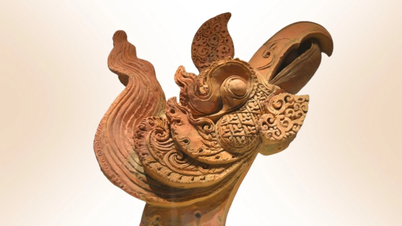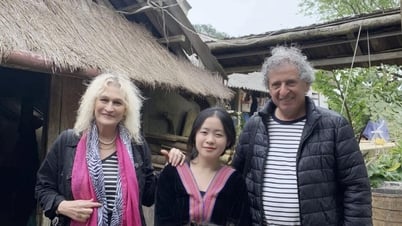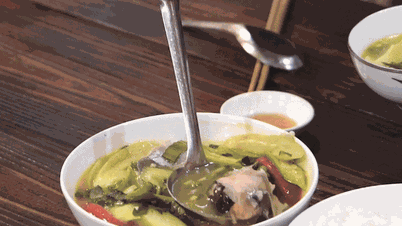Once a familiar material in folk art, used for painting, preserving ancient documents, writing calligraphy, etc., dó paper is now being “reborn” in a new form by young people. Not only preserving a heritage, they are continuing and reviving the cultural story in their own creative and contemporary way.

Awakening traditional values
Doan Thai Cuc Huong is a girl of the 9x generation with a modern appearance. However, after many years of living and studying in the West, Huong chose to return and stick with a material that seems strange to young people: Do paper.
In a small, sunlit room on Dong Tac Street (Dong Da District), Huong talked to me while carefully smoothing each fold of paper, cherishing it as if she were conversing with fragments of memories. Do paper, under her soft hands and creative mind, has been revived into items that are both traditional in appearance and imbued with the breath of the times. Folding fans printed with contemporary motifs, handmade notebooks with retro (classic) inspiration, lanterns, lanterns sparkling with the light of childhood, or even jewelry, postcards, envelopes... all exude a unique, very individual beauty.
Huong said that Do paper used to be the pride of the nation. Do paper is also a symbol of sophistication and durability. Through dozens of meticulous manual steps - from processing the Do bark, pounding, filtering the powder, to drying the paper... - the finished paper is as light as a wick, soft as silk, thin as a dragonfly's wing but possesses incredible durability. In a humid tropical monsoon climate like Vietnam, Do paper can last for hundreds of years without mold or rotting.
Because of these valuable qualities, Do paper was once used by feudal dynasties to write royal decrees, print scriptures, write calligraphy, paint folk paintings... Ancient people also used Do paper to make Mid-Autumn Festival lanterns, lanterns, and lanterns to hang in front of their houses during holidays and Tet. But then, following the transformation of the industrial age, Do paper gradually gave way to more modern materials - cheaper, more convenient, and therefore, the old applications gradually faded into oblivion.
For Doan Thai Cuc Huong, the opportunity to come to dó paper began by chance. While attending a dried flower making course to regain balance in life, she accidentally touched a piece of dó paper. The rough, dark-colored paper and the rustic grain lines seemed to carry the breath of the earth, making her exclaim: “So beautiful!”. At that moment, although she had not yet determined her future, the seed of love for dó paper had quietly sprouted in her.
Later, after leaving her job at a traditional paper manufacturing company, Huong started to create small products from Do paper. Unexpectedly, the reception and encouragement from her friends made Huong start to seriously think: "Should I really do handicrafts?"
In 2021, Huong spent 5 months diligently researching, experimenting, and learning. While reading, working, she asked herself: “What can Do paper become? How can we preserve the traditional spirit while breathing new life into it?” The more she devoted herself, the more fascinated she became by the enduring beauty and flexible application of the paper that was once associated with royal decrees, calligraphy, and folk paintings.
From those thoughts and passions, Huong has created products imbued with Vietnamese identity such as folding fans, lanterns, notebooks inlaid with Bodhi leaves... Not simply souvenirs, each product is like a cultural puzzle, where the past and the present coexist through the hands and emotions of a young person.
Realizing that dó paper is suitable for making wood carvings, Doan Thai Cuc Huong now also makes wood carvings to print on lampshades with beautiful ancient patterns. Huong shared that she is not only making handicrafts but also telling stories with dó paper. Each product is a conversation between tradition and modernity, between the past and the future. “Every time I fold a fan or design a postcard from dó paper, I think of how my grandparents used dó paper to write letters and draw pictures. Now, I continue to write that story, but in a young person's way,” Huong shared.
Bringing Do paper back to contemporary life
Not only does it create beautiful, highly applicable handicrafts like Doan Thai Cuc Huong, do paper is also a source of inspiration for many art enthusiasts. The fine art creations on do paper by the female artist born in 1988 - Hoang Huong Giang is an example.
With the desire to pursue a creative path systematically, Hoang Huong Giang majored in fine arts at the Hanoi Academy of Theatre and Cinema. After graduating, while many friends chose the path of modern art, or tried their hand at popular materials on the market, Giang chose a different path: Painting on Do paper.
For artist Hoang Huong Giang, more than just a material, Do paper is a part of the soul of traditional art. It helps connect the past and the present, conveying values not only of the nation but also of Giang herself in each work.
Thanks to Do paper, through the gentle colors and soft lines, the lotus paintings - the main inspiration in Giang's works - exude a spirit of awakening. Through the paintings, viewers not only admire the beauty but also find peace in every detail. It is known that currently, besides creating on Do paper, the female artist also opens many non-profit drawing classes, instructing children on art appreciation to nurture and foster in young souls a passion for colors and painting.
With a deeper desire to bring Do paper back to modern life in a new form, Mr. Hoang Tien Quyet (born in 1989) has brought the art of Origami closer to everyone. Origami is a paper folding art originating from Japan. Instead of using the common industrial paper, Quyet chose Do paper to create impressive Origami works. And not stopping there, he also applied the "wet folding" technique - a difficult paper folding method, allowing the folds to be softly curved and hold the shape like a miniature sculpture.
A cat playing in the sun, clever little mice, cranes spreading their wings in the sky or a fat hippo resting on the riverbank... all are shaped from dó paper, appearing like a magical world . The seemingly lifeless pieces of paper, under the hands and heart of the young artist, suddenly become alive, carrying the soul and breath of the new era. Choosing dó paper is not only an artistic decision, but also a choice with cultural depth. In each fold, each work, is a story about the connection between tradition and modernity, between national identity and international integration.
Looking at young people like Hoang Tien Quyet, Hoang Huong Giang, Doan Thai Cuc Huong, although each person follows a different path, they all have in common the respect for traditional materials and the desire to bring them back to modern life in a new, creative form that is closer to young people.
In the context of globalization, when the flat world is opening up countless options, the return of young people to traditional materials to create and innovate is a welcome sign. It shows that tradition is not something old, out of date, but can be completely renewed, transformed, and continue to accompany the pace of modern life. And who knows, from those fragile pieces of paper, once again, Vietnamese culture will find a way to spread more strongly, more deeply, not only domestically but also to international friends.
Source: https://hanoimoi.vn/geo-mam-sang-tao-tren-nen-giay-xua-700518.html




































































































Comment (0)